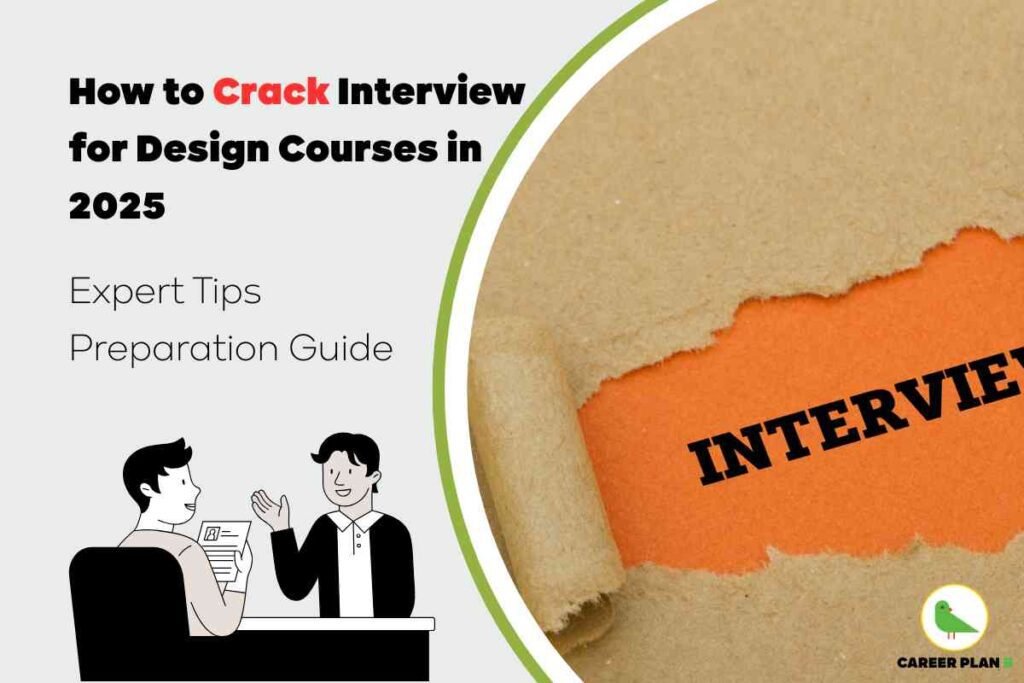Introduction
Are you preparing to crack the interview for top design courses in 2025? Whether it’s NID, NIFT, UID, or MIT-ID, the interview round plays a crucial role in your admission journey. It’s not just about creativity—it’s about communicating your thought process, passion for design, and presenting your portfolio in the best light. In this blog, we’ll cover everything you need to know: the purpose of these interviews, the types of questions you may face, how to showcase your portfolio effectively, and mistakes to avoid. Plus, gain insider tips from mentors and toppers who’ve aced their design interviews. Let’s get you interview-ready!
Table of Contents
The Purpose of the Design School Interview
Before you start preparing, it’s essential to understand what the interview panel is looking for. They want to assess:
- Your Passion: Are you genuinely enthusiastic about design?
- Your Creativity: How do you think and approach problems?
- Your Self-Awareness: Do you understand your strengths and weaknesses?
- Your Teachability: Are you open to learning and receiving feedback?
- Your Fit: Do your goals align with the philosophy and offerings of the institute?
The interview is a conversation designed to uncover these qualities.
Key Preparation Steps for Interview Success
Confidence comes from preparation. Follow these steps to build a strong foundation for your interview.
1. Research the Institute Thoroughly
This is a non-negotiable step. Answering “Why do you want to study here?” with a generic response is a major red flag. Dive deep into the institution’s:
- Philosophy and Vision: What makes this school unique?
- Faculty: Are there any professors whose work you admire?
- Alumni: Who are their notable graduates, and what have they achieved?
- Curriculum: Are there specific subjects or specializations in the course that excite you?
Knowing these details will allow you to give specific, thoughtful answers that demonstrate your genuine interest.
2. Curate and Master Your Portfolio
Your portfolio is the centerpiece of your interview. Don’t just show your work; present it with a compelling narrative.
- Select Your Best Pieces: Choose a handful of your strongest projects that showcase a range of skills and creativity. Quality over quantity is key.
- Tell the Story of Each Project: Be prepared to discuss each piece in detail. Explain your initial idea, the process you followed, the challenges you encountered, and what you learned. This reveals your thought process.
- Organize it Logically: Arrange your portfolio in a clean, professional manner that is easy for the panel to follow.
3. Craft Your Personal Narrative
The question “Tell me about yourself” is inevitable. Don’t just list your accomplishments. Instead, craft a short, engaging story that connects your background, experiences, and passion for design. Explain what led you to pursue this career path and how your journey has prepared you for this next step.
Common Design Interview Questions & How to Answer Them
Be prepared to answer a mix of personal, technical, and creative questions.
Personal and Motivational Questions
- “Why have you chosen this specific design field (e.g., fashion, graphic, product)?”
Connect your personal interests and skills to the specific discipline. For example, if you’re applying for graphic design, talk about your love for visual storytelling and communication. - “What are your biggest strengths and weaknesses?”
For strengths, choose qualities relevant to a designer (e.g., creativity, attention to detail, empathy). For weaknesses, be honest but frame it positively. Name a genuine area for improvement and explain what you’re doing to work on it. - “Where do you see yourself in five years?”
Show that you have clear career ambitions. Talk about the kind of work you hope to be doing and explain how studying at this particular institute is the crucial first step in your plan.
Design and Industry Awareness Questions
- “Who is your favorite designer, and why?”
Choose a designer whose work genuinely inspires you. Go beyond the name and analyze their aesthetic, their impact on the industry, or their innovative techniques. This shows a deeper level of critical thinking. - “What are some current design trends that interest you?”
This tests your industry awareness. Be specific. Mention a trend, discuss its origins, and offer your opinion on it. This proves you are engaged with the contemporary design world. - “What, in your opinion, constitutes ‘good design’?”
There is no single right answer. This question assesses your design philosophy. A strong answer might touch upon functionality, aesthetics, user experience, and sustainability, showing a well-rounded understanding of design principles.
How to Present Your Portfolio with Impact
Even if a portfolio is not mandatory, presenting your work — sketchbooks, craftwork, digital designs, or model prototypes — can set you apart.
Tips to Showcase Your Work:
- Start with your most impressive and unique project
- Describe the problem-solution journey for each piece
- Use visuals that are clean, well-scanned, or photographed
- Avoid clutter; let your design breathe on the pageghlight originality and functionality, not just beauty
Common Mistakes to Avoid in Design Interviews
- Memorizing scripted answers (it shows!)
- Submitting copied or unoriginal portfolio work
- Lack of clarity in presenting your design process
- Arguing or being defensive during feedback
- Overexplaining or underexplaining your work
- Ignoring current design trends or news
What Top Colleges Like NID, NIFT & MIT-ID Look For
According to insights shared by interviewers from NIFT Delhi and MIT Pune:
- Original thinking, not replication
- Curiosity to learn and grow
- Awareness of how design affects society
- Sensitivity to culture, diversity, and inclusivity
- Clarity of purpose and design process
Do's and Don'ts for the Interview Day
Your conduct and professionalism are just as important as your answers.
Do’s and Don’ts for Design Course Interviews
| Do’s | Don’ts |
|---|---|
| Dress Thoughtfully Your outfit should be neat and professional but also reflect your personal style. | Argue with the Panel It’s okay to have a different opinion, but express it respectfully. Avoid being confrontational. |
| Be Punctual Arrive on time, whether the interview is in-person or online. Punctuality shows respect. | Lie or Exaggerate Be honest about your skills and experiences. Authenticity is more impressive than false claims. |
| Maintain Eye Contact Engage with all the interviewers. It projects confidence and keeps them involved. | Use Filler Words Avoid “um,” “ah,” and “like.” Speak clearly and confidently. It’s okay to pause to gather your thoughts. |
| Ask Insightful Questions Prepare a few questions for the panel about the course, the culture, or student life. | Forget Your Portfolio Have your portfolio ready and be prepared to discuss every single piece within it. |
Listen Actively |
FAQs About Design School Interviews
Q: Do I need to be an amazing artist or sketcher to get in?
A: While drawing skills are helpful, colleges are primarily looking for creativity, original ideas, and a unique perspective. Your ability to think like a designer is more important than your technical drawing skill.
Q: What if I get nervous and freeze up?
A: It’s normal to be nervous. Take a deep breath. If you need a moment to think, it’s perfectly fine to say, “That’s a great question, let me take a moment to think about that.”
Q: What should I do after the interview?
A: Sending a brief, polite thank-you email within 24 hours is a professional gesture that reinforces your interest in the program.
Final Interview Day Checklist
- Arrive early and stay calm
- Carry a clean, organized portfolio
- Dress comfortably and neatly
- Maintain eye contact and smile
- Don’t bluff or fake your knowledge
- Thank the panel at the end with confidence
Conclusion: Think Like a Designer, Speak Like a Problem Solver
Cracking a design interview in 2025 is not about flashy graphics or perfect sketches. It’s about your mindset. Show that you are an observer, a thinker, and a creator who understands the power of design in the real world.
If you prepare thoughtfully, remain authentic, and present your work confidently, you’re already halfway there. Good luck with your creative journey!
Want Personalized Design Interview Preparation for 2025?
At Career Plan B, we help design aspirants like you succeed with:
✅ Mock interviews tailored to NID, NIFT, UID, MIT-ID, and other top design institute formats
✅ Portfolio coaching to sharpen your storytelling, creativity, and visual presentation
✅ Personalized feedback on communication, confidence, and interview etiquette
✅ Insider insights into what top design colleges look for in candidates
🎓 Book Your Free 1-on-1 Design Interview Strategy Call Today
Talk to our expert design mentors and take the first step towards your dream college!



